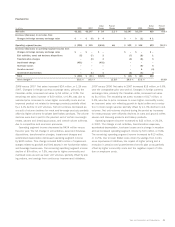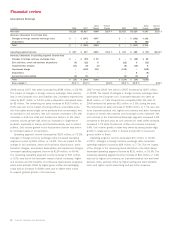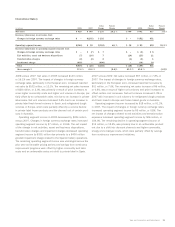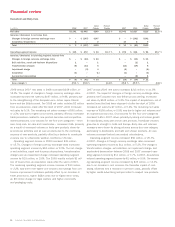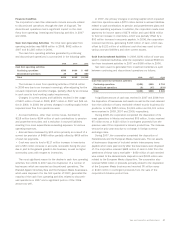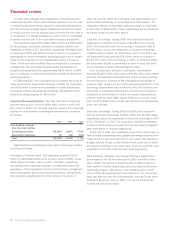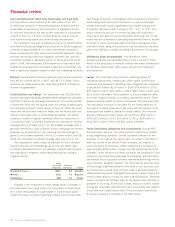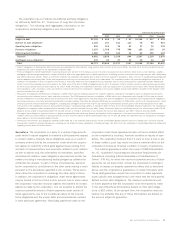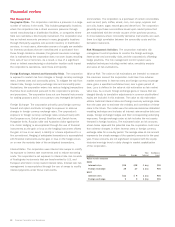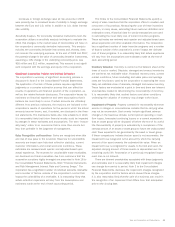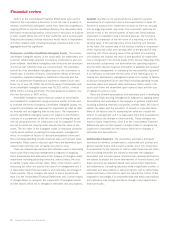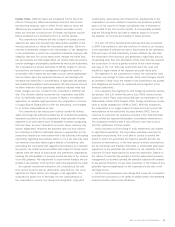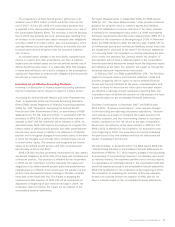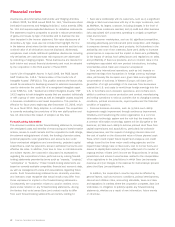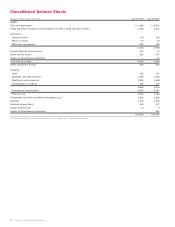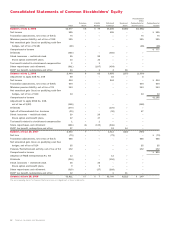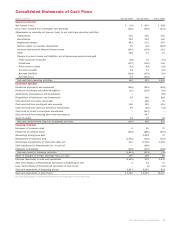Sara Lee 2008 Annual Report Download - page 35
Download and view the complete annual report
Please find page 35 of the 2008 Sara Lee annual report below. You can navigate through the pages in the report by either clicking on the pages listed below, or by using the keyword search tool below to find specific information within the annual report.Increases in foreign exchange value at risk amounts in 2008
were primarily due to increased levels of volatility in foreign exchange
between the Euro and U.S. dollar, in addition to U.S. dollar interest
rate volatility.
Sensitivity Analysis
For commodity derivative instruments held, the
corporation utilizes a sensitivity analysis technique to evaluate the
effect that changes in the market value of commodities will have on
the corporation’s commodity derivative instruments. This analysis
includes the commodity derivative instruments and, thereby, does
not consider the underlying exposure. At the end of 2008 and 2007,
the potential change in fair value of commodity derivative instruments,
assuming a 10% change in the underlying commodity price, was
$16 million and $11 million, respectively. This amount is not signifi-
cant compared with the earnings and equity of the corporation.
Significant Accounting Policies and Critical Estimates
The corporation’s summary of significant accounting policies is
discussed in Note 2 to the Consolidated Financial Statements.
The application of certain of these policies requires significant
judgments or a complex estimation process that can affect the
results of operations and financial position of the corporation, as
well as the related footnote disclosures. The corporation bases its
estimates on historical experience and other assumptions that it
believes are most likely to occur. If actual amounts are ultimately
different from previous estimates, the revisions are included in the
corporation’s results of operations for the period in which the actual
amounts become known, and, if material, are disclosed in the finan-
cial statements. The disclosures below also note situations in which
it is reasonably likely that future financial results could be impacted
by changes in these estimates and assumptions. The term “reason-
ably likely” refers to an occurrence that is more than remote but
less than probable in the judgment of management.
Sales Recognition and Incentives Sales are recognized when title
and risk of loss pass to the customer. Reserves for uncollectible
accounts are based upon historical collection statistics, current
customer information, and overall economic conditions. These
estimates are reviewed each quarter and adjusted based upon
actual experience. The reserves for uncollectible trade receivables
are disclosed and trade receivables due from customers that the
corporation considers highly leveraged are presented in Note 18 to
the Consolidated Financial Statements, titled “Financial Instruments
and Risk Management Interest Rate and Currency Swaps.” The
corporation has a significant number of individual accounts receivable
and a number of factors outside of the corporation’s control that
impact the collectibility of a receivable. It is reasonably likely that
actual collection experience will vary from the assumptions and
estimates made at the end of each accounting period.
The Notes to the Consolidated Financial Statements specify a
variety of sales incentives that the corporation offers to resellers and
consumers of its products. Measuring the cost of these incentives
requires, in many cases, estimating future customer utilization and
redemption rates. Historical data for similar transactions are used
in estimating the most likely cost of current incentive programs.
These estimates are reviewed each quarter and adjusted based upon
actual experience and other available information. The corporation
has a significant number of trade incentive programs and a number
of factors outside of the corporation’s control impact the ultimate
cost of these programs. It is reasonably likely that actual experience
will vary from the assumptions and estimates made at the end of
each accounting period.
Inventory Valuation Inventory is carried on the balance sheet at the
lower of cost or market. Obsolete, damaged and excess inventories
are carried at net realizable value. Historical recovery rates, current
market conditions, future marketing and sales plans and spoilage
rates are key factors used by the corporation in assessing the most
likely net realizable value of obsolete, damaged and excess inventory.
These factors are evaluated at a point in time and there are inherent
uncertainties related to determining the recoverability of inventory.
It is reasonably likely that market factors and other conditions
underlying the valuation of inventory may change in the future.
Impairment of Property Property is tested for recoverability whenever
events or changes in circumstances indicate that its carrying value
may not be recoverable. Such events include significant adverse
changes in the business climate, current period operating or cash
flow losses, forecasted continuing losses or a current expectation
that an asset group will be disposed of before the end of its useful
life. Recoverability of property is evaluated by a comparison of the
carrying amount of an asset or asset group to future net undiscounted
cash flows expected to be generated by the asset or asset group.
If these comparisons indicate that an asset is not recoverable, the
impairment loss recognized is the amount by which the carrying
amount of the asset exceeds the estimated fair value. When an
impairment loss is recognized for assets to be held and used, the
adjusted carrying amount of those assets is depreciated over its
remaining useful life. Restoration of a previously recognized impair-
ment loss is not allowed.
There are inherent uncertainties associated with these judgments
and estimates and it is reasonably likely that impairment charges
can change from period to period. Note 3 to the Consolidated
Financial Statements discloses the impairment charges recognized
by the corporation and the factors which caused these charges.
It is also reasonably likely that the sale of a business can result in
the recognition of an impairment that differs from that anticipated
prior to the closing date.
Sara Lee Corporation and Subsidiaries 33


